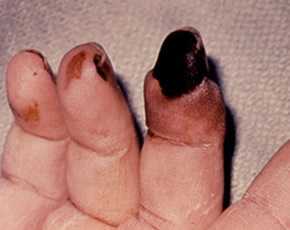
Rheumatoid Vasculitis
Rheumatoid vasculitis is a rare but potentially devastating complication of rheumatoid arthritis. Considering the emphasis on tight control of rheumatoid arthritis disease activity of the past decade, one might expect to see a decline in such devastating extra-articular manifestations. However, studies have not uniformly demonstrated declines in rates of rheumatoid vasculitis over time. Here, Bartels et al. (Arthritis Rheum 2009; 60(9): 2553) explore the recent temporal trends in the prevalence of rheumatoid vasculitis among male veterans receiving care within the Veterans Health Administration.
Methods
Trends in prevalence of rheumatoid vasculitis over the period 1985-2006 (for inpatients) and 1997-2006 (for outpatients) among 10 million hospitalizations and outpatient visits from an annual census of more than 37,000 male veterans included within the administrative database of the Veterans Health Administration. The diagnosis of rheumatoid vasculitis was based on codes for arteritis, mononeuritis multiplex, peripheral neuropathy due to connective tissue disease, gangrene, and chronic ulcers, in rheumatoid arthritis patients who did not have diabetes. Inpatient and outpatient visits were considered separately.
Results
Consistent with the demographic make-up of Veterans Health Administration patients, rheumatoid arthritis patients were primarily men (>92%) with an average age of 65 years. Among hospitalized veterans, the peak prevalence of rheumatoid vasculitis was 5% in 1985 (the beginning of the study period). Rheumatoid vasculitis prevalence declined among inpatients over time, with a clear breakpoint between 2000 and 2001, in which the rate decreased from 32 cases per 1,000 RA patients to 15 cases per 1000 RA patients. Among outpatients, the peak prevalence of rheumatoid vasculitis was almost 4% in 1997, with temporal declines noted thereafter. Similar to inpatients, there was a clear break in the prevalence of rheumatoid vasculitis among outpatients between 2000 and 2001, in which the rate decreased from 41 cases per 1,000 RA patients to 28 cases per 1000 RA patients.
Conclusions
There has been a temporal decrease in the prevalence of rheumatoid vasculitis among inpatient and outpatient veterans over the past decades, with a dramatic decrease in prevalence between the years 2000 and 2001.
Editorial Comment
The strengths of this study are the large number of patients involved and data collection that goes back more than two decades. It is interesting that an abrupt drop-off in the prevalence of rheumatoid vasculitis was observed around the year 2000. While it is tempting to attribute this to the beginning of the era of biologic therapy in RA patients, the study presented here does not present the fine detail required to prove this inference. Since the diagnosis of rheumatoid vasculitis was based on administrative coding and not more objective evidence (such as biopsy), then there is potential for misclassification of the outcome. For example, the diagnosis of hepatitis C related arthritis (which can present with joint pain and an elevated rheumatoid factor, frequently misdiagnosed as rheumatoid arthritis) and its complication of cryoglobulinemic vasculitis has changed over time. If these patients were included in the rheumatoid vasculitis group in the past, but now accurately classified, then this could account for some of the decline in rates of rheumatoid vasculitis observed in this study. Regardless, it is encouraging that the current prevalence of rheumatoid vasculitis remains quite low, considering how devastating this complication can be for affected individuals.

